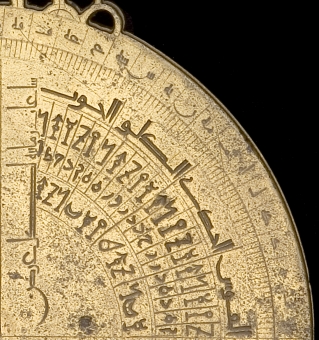| Date | 984/5 or 1003/4 (A.H. 374 or 394) |
| Maker | Aḥmad and Muḥammad |
| Place | Iṣfahān |
| Material | Brass |
| Inventory no. | 33767 |
| Acquisition | Presented by Lewis Evans in 1924 |
This early Persian astrolabe, the oldest dated astrolabe in the collection, reflects conventions that were common to Greek instruments. As with Greek instruments, most of the plates lack azimuth lines. More interesting, however, is the set of planetary symbols used in the tables of astrological terms and faces found on the back of the instrument.
The tables of terms and faces on this instrument are distributed in an unusual manner, stretching across three quarters of the back of the instrument, in contrast to the more typical semicircle tables found on most Islamic instruments. Another unusual feature is that the maker used symbols to denote the planets rather than the last letter of the name of the planet. The most striking feature of this table, however, is the symbols themselves, which derive from the Greek symbols for the planets.
In the picture, the outer ring of text shows the last third of the zodiac — going anticlockwise from Sagittarius (القوس) to Pisces (الحوت). The next ring are the symbols for the terms — Jupiter looks like a horizontal Z; next comes Venus, Mercury, Saturn and Mars. The next ring gives the number of degrees for each term. Finally, the inner ring shows the symbols for the astrological faces: Mercury, the moon, Saturn, Jupiter, Mars, the sun, Venus. These symbols can be compared to other similar tables on astrolabes linked below.
View all
images for this astrolabe
View
detailed provenance for this astrolabe
Mater
The mater and limb are of two pieces, soldered construction. The limb has separated from the back plate. The plates are held in place by a post on the meridian line near the bottom of the instrument. Scales on the limb: degree scale. More informationBack
The back contains 5 scales of the following types: Altitude; Dastūr Circle; Zodiacal signs; Terms; Faces. The back is inscribed: with a maker's signature marked as بسم الله وبعون الله باليمن والدولة وباﻹقبال والسعادة ألف هذا الأصطرلاب أحمد ومحمد أبناء ٳبراهيم الأصطرلابي الأصفهاني سنة أربع وتسعين وثلثمائةة (In the name of God, and by the help of God. With prosperity and success and good fortune and happiness, this astrolabe was composed by Aḥmad and Muḥammad, sons of Ibrāhīm, maker of astrolabes from Isfahan, the year 394.). Inscription across middle of back. with a marked as [vertically on the back]. [ pending ]. More informationRete, Pin & Horse
The rete contains 38 stars. The zodiac on the rete is labelled: ال , الثور , الجوزا , السرطان , الاسد , السنبله , الم , , , , الدل , الحوت.The rete contains 1 scale of the following type: Ecliptic.
The rete is attached using a pin & horse. More information



